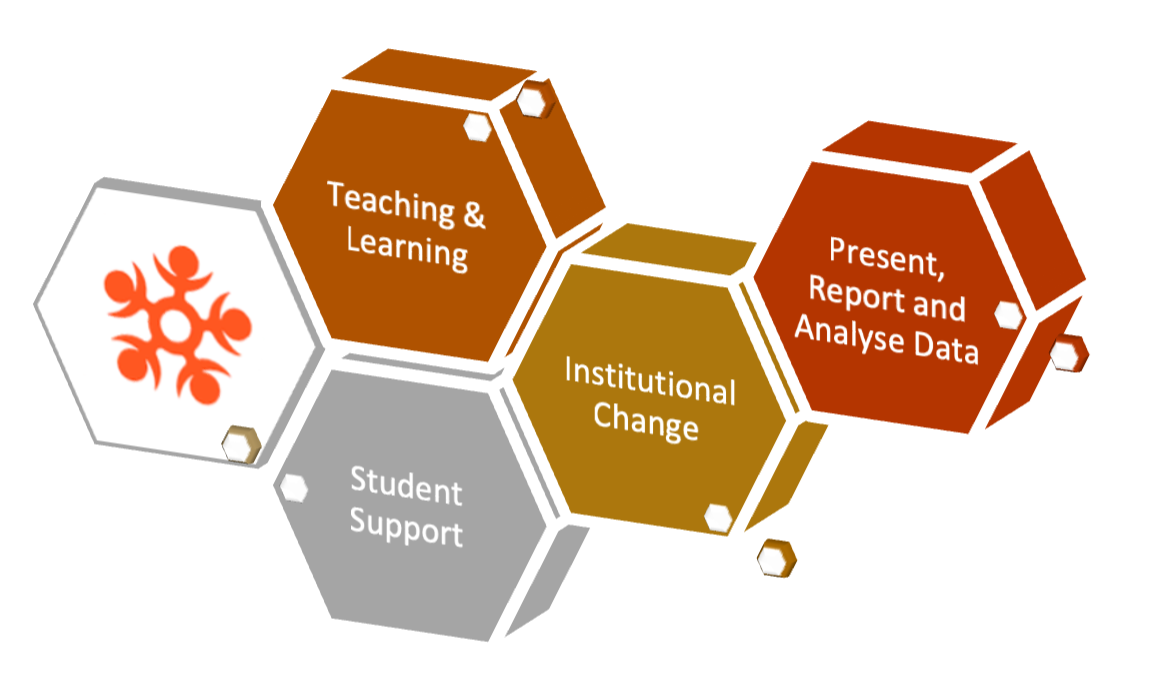
Designing a Short Learning Programmes is as easy as 1,2,3
Koo Parker and Maryla Bialobrzeska
In Siyaphumelela 3.0, Service Workshops have been reimagined as Short Learning Programmes (SLPs). These SLPs are designed to offer accessible, activity-based professional development opportunities created by network partner institutions with support from Saide.
Each SLP aligns with one of three competency levels—basic, intermediate, or advanced—and is based on the Knowing-Doing-Transforming framework from the Siyaphumelela Theory of Change. SLPs aim to provide practical knowledge across several focus areas (Figure 1) including:
- Student Support;
- Present, Report and Analyse Data;
- Institutional Change; and
- Teaching and Learning;
Figure 1: Theory of Change and SLP focus areas
Built on Saide’s web-based platform, SLPs are made freely available to all institutions on the Siyaphumelela website.
The SLP Design Course
In September, a cohort of network institutions participated in Saide’s online SLP Design course which spanned three weeks and covered three, 3-hour modules:
Module 1: Use of an Online Course to Explore Learning Design
Module 2: Tools and Strategies to Support Learning Design
Module 3: Use of the Planner App and the Evaluation Tool.
Module 1 introduces the core components of a short learning programme, such as topics, activities, use of multimedia, ICT tools and assessments. The course highlighted that design choices reflect the learning approach, which can range from didactic to transformative, and emphasized using technology to facilitate learning and interaction rather than merely transmit information. To this end, the CAT (Collaboration – Authentic Learning – Tools) framework was introduced as a useful first-step to inform design choices (Figure 2).
Since all Siyaphumelela SLPs will be offered online, integrating technology and media that support learning is essential. In the first module, participants critically assessed an existing Saide online course. From the outset, the design course promotes an active and authentic learning approach that models “learning by doing”.
Figure 2: The Collaboration, Authentic Learning, and Tools (CAT) Framework
Module 2 continues to explore the blend of theory and application in learning design, introducing Engestrom’s (2001) theory of learning as the basis for five guiding questions in the design of an SLP. Getting to the nuts and bolts of the course, the participants engaged in two key activities: learning to use the Planner App and utilizing ChatGPT to generate scenarios and design authentic learning and assessment tasks. The Planner App is structured around the five questions, with detailed explanations provided at each step of the design process (Figure 3).
Figure 3: Five questions to guide learning design and evaluation.
https://www.siyaphumelela.org.za/pathways/633282/
Module 2 concludes with a homework task, where participants use the Planner App, structured around the five design questions (Figure 4) and ChatGPT to develop and upload a unit of learning that includes at least two authentic tasks.
Figure 4: Designing an SLP using the Planner App
Module 3 brings it all together in an Integrated Learning Design Framework. Participants presented the units of learning which they designed with ample opportunity provided for discussion and feedback from the facilitators and participants.
Upon completing the course, the participants were asked to rate their confidence in developing SLPs. The responses indicated an average confidence level of 7.75 on a 10-point scale.
Key participant takeaways and reflections included:
“ … appreciating the value of activity-based learning and using multi-media”
“ Emphasising real-world tasks … and practical application”
“Exploration of ChatGPT to develop content for authentic learning”
“ … using the Planner App for module development"
“Going through the examples of other modules planning”
“Planner App helps with structure of the SLP and ChatGPT can help with activities”
“There was substantial use of technology (Planner App, ChatGPT etc.) so you had to focus …This is not a workshop where you can multitask (LOL!)”

